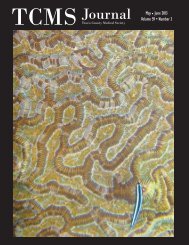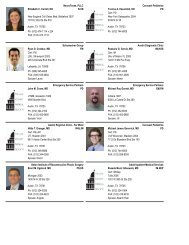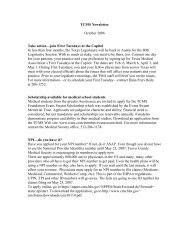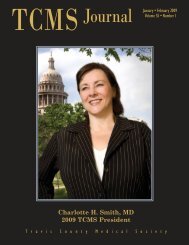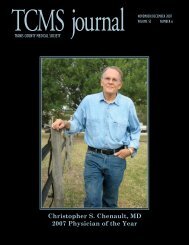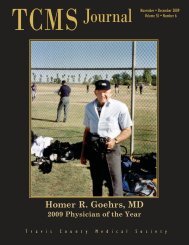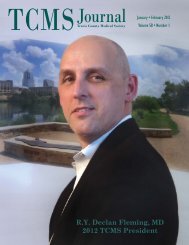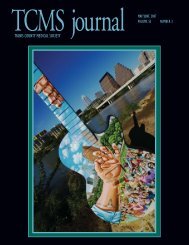May ⢠June 2009 - Travis County Medical Society
May ⢠June 2009 - Travis County Medical Society
May ⢠June 2009 - Travis County Medical Society
- No tags were found...
You also want an ePaper? Increase the reach of your titles
YUMPU automatically turns print PDFs into web optimized ePapers that Google loves.
TCMS Journal<strong>May</strong> • <strong>June</strong> <strong>2009</strong>Volume 55 • Number 3T r a v i s C o u n t y M e d i c a l S o c i e t y
Matador is Francisco "Paco" Aviña and the bull was named Valiente (which means “brave”). Photo by Wylie Jones Jordan, MD.2 <strong>May</strong> • <strong>June</strong> <strong>2009</strong> TCMS Journal
DELEGATION REPORTTexMed <strong>2009</strong>Michelle A. Berger, MDTCMS Delegation ChairAMA Alternate DelegateThe TMA House of Delegates met <strong>May</strong>1 and 2 during TexMed, the Association’sannual meeting. The <strong>Travis</strong> <strong>County</strong><strong>Medical</strong> <strong>Society</strong> was well represented byits elected Delegation of more than fiftyphysicians. Several <strong>Travis</strong> <strong>County</strong> leaderswere re-elected to state and nationalpositions including: Charlotte Smith,MD as AMA Alternate Delegate; BruceMalone, MD and David Fleeger, MD asAMA Delegates; and Cliff Moy, MD asAMA Delegate and Vice-Speaker of theTMA House. Finally, it was my distincthonor to be elected as the newest AMAAlternate Delegate from Texas.As a result of revisions to Houseprocedures made by Speaker StephenBrotherton, MD of Ft. Worth and ourown Dr. Cliff Moy, Vice Speaker, thebusiness of the House was conductedmore efficiently than ever. The House ofDelegates received numerous reports andacted on multiple resolutions that willguide TMA councils and committeesand shape TMA policy.A <strong>Travis</strong> <strong>County</strong> Resolution wasadopted for TMA to support theestablishment of an advance directiveregistry by Centers for Medicare andMedicaid Services (CMS) in a mannerthat would make it accessible for verificationby health care professionals; andsupporting a CMS requirement forMedicare patients to register theadvanced directive of their choice tofacilitate their end-of-life preferencesbeing respected.William H. Fleming, MD ofHouston was installed as the new TMApresident and D’Aviria Uvek of Tyler asthe TMA Alliance president. Sue RuddBailey, MD, a Fort Worth allergist, waselected by acclamation as president-electof TMA and three new members wereelected to the TMA Board of Trustees:Lewis Foxhall, MD, a family physicianfrom Houston, Don Read, MD a Dallasrectal surgeon and San Antonio pathologistDavid Henkes, MD. The newmedical student trustee is Spencer Pruittfrom UT-Houston and the residentsre-elected Rebecca Wiatrek, MD.Michael Speer, MD of Houston is thenew chair of the board and CarolynEvans, MD of Dallas the new vice chair.Finally, the <strong>Travis</strong> <strong>County</strong> <strong>Medical</strong> <strong>Society</strong>announced its intention to nominate C.Bruce Malone, MD for TMA presidentelectin <strong>May</strong> 2010.The <strong>Travis</strong> <strong>County</strong> delegation representsyou at the TMA level. Please feelfree to contact me, our Delegation vicechair Jim Eskew, or any member of theDelegation with issues or concerns youwould like presented to the TMA in theform of a resolution. If you have aninterest in becoming involved in representing<strong>Travis</strong> <strong>County</strong> at the state level,we would love to hear from you.Michelle A. Berger, MDAMA Alternate DelegateC. Bruce Malone, MDAMA DelegateCharlotte H. Smith, MDAMA Alternate DelegateDavid C. Fleeger, MDAMA DelegateCliffored K. Moy, MDAMA Delegate andVice Speaker, TMA House of DelegatesTCMS Journal <strong>May</strong> • <strong>June</strong> <strong>2009</strong> 5
continued from page 4often as long as 6-12 months post injury.There is no outpatient therapy availablefor the patients after they leave thehospital.The rehabilitation efforts inKunming were innovative and intensive.Because there were no physical therapists,family members performed most ofthe therapy after being taught by thenursing staff. Seventeen days aftersurgery, patients are initiated into anintensive locomotor program in whichthey are ambulated by family memberswho either move their legs manually oruse ropes to facilitate leg movements.Some of these patients required up to 4people to assist them for each laboriousstep. After early morning wheelchaircalisthenics, each patient walked for 3hours, followed by a one hour lunchbreak/nap and then an additional 3 hourperiod of walking, totaling 6 hours ofambulation per day, 6 days per week.There were also many treatments thataren’t typically seen in the US – Orientalmedicine modalities such as acupuncture,manual medicine, herbal medications, andbaths with tea, minerals, and herbs.Although there were many patientswho appeared to have progressedfunctionally, it was difficult to assessexactly how much neurological progresswas being made by individual patients.What was striking was how few of thenormal medical complications typical forSCI patients (such as decubitus ulcers,deep venous thrombosis, pulmonarycomplications, bladder and bowel issues,etc.) were seen, even in the absence ofbedside nurses, physical therapists, respiratorytherapists, and other medicalprofessionals. I only saw two individualswith urinary catheters in place, despite thefact that most of these patients wereacutely injured.Locomotor patterning is showingtremendous potential in SCI recoveryprograms. In the US, we use differentmethods − treadmills, harnesses, functionalelectrical stimulation, and robotictherapies. In my experience, there arevery few US families that would be ableto replicate the Chinese ambulationprotocols. It would be difficult for mostUS families to have multiple familymembers take off work 6 days per weekfor 6-12 months. In fact, it is oftendifficult to get family members in foreven one day to accomplish training andeducation in preparation for discharge.After decades of managing SCIpatients, I’ve observed that thefunctional level and neurological levelsdo not always correlate. It turns out thatone of the most important prognosticindicators after SCI is having asupportive family that is willing to helpthe patient be as functional as possibleafter their injury.While I would never want to give upthe remarkable medical advances andtechnologies that we enjoy in ourcountry, it seems that there is much wecan learn from our colleagues in Chinaabout the effectiveness of engagingfamilies as a rich resource in facilitatingrecovery. <strong>May</strong>be there is a middle groundto be found between Western technologyand Eastern tradition; a balance betweenhigh tech and high touch.Board of EthicsDelegates to TMAWilliam D. Caldwell, MDIra Bell, MDTCMS members represent you at the state and national level.Toni Funicello, MDMichelle A. Berger, MD*Bruce A. Levy, MD, JD, ChairRobert E. Blais, MDJeffrey Jekot, MDRoberta M. Braun, MDHillary Miller, MDC. Mark Chassay, MDClifford K. Moy, MDWilliam J. Deaton, MDArchie Dan Smith, MDJames Eskew, MD**Lisa C. Ellis, MDExecutive BoardCharlotte H. Smith, MD, PresidentC. Mark Chassay, MD, President ElectTMA House of DelegatesClifford K. Moy, MD, Vice SpeakerMichael L. Gutierrez, MDJames M. Hicks, MDFelix Hull, MDPhillip C. Collins, MD, Immediate Past PresidentDelegates to AMAJeffrey M. Jekot, MDCharles (Bill) Bailey, MD, JDThomas D. Kirksey, MDBrian Sayers, MD, Secretary-TreasurerDavid C. Fleeger, MDGreg M. Kronberg, MDRobert K. Cowan, MD, Member At LargeC. Bruce Malone, MDR.Y. Declan Fleming, MD, Member At LargeClifford K. Moy, MDHillary Miller, MD, Member At LargePaula S. Oliver, MD, Member At LargeAdam J. Schneider, MD, Member At LargeSarah I. Smiley, DO, Member At LargeAlternate Delegates to AMACharlotte H. Smith, MDMichelle A. Berger, MDBruce A. Levy, MD, JD, Chair, Board of EthicsMichelle A. Berger, MD, Delegation RepresentativeStephen S. Clark, MD, BTC RepresentativeAMA Board of TrusteesJoseph P. Annis, MDAMA Young Physician SectionGoverning CouncilDawn Buckingham, MD, Chair-electHillary Miller, MDHector E. Morales, MDPatrick S. Pevoto, MDPeggy M. Russell, DODora L. Salazar, MDCatherine L. Scholl, MDCharlotte H. Smith, MDEric S. Tiblier, MDEmilio M. Torres, MDDennis E. Welch, MDRobert P. Wills, MDGuadalupe “Pete” Zamora, MD* Chair** Vice-ChairAlternate Delegates to TMASara Austin, MDBruce A. Levy, MD, JDTony Aventa, MDJerald A. Mankovsky, MDCraig T. Berent, MD Carla F. Ortique, MDDawn C. Buckingham, MD Paula S. Oliver, MDEdward D. Buckingham, MD Jack Pierce, MDJane E. Braunstein, MD Robina N. Poonawala, MDWilliam D. Caldwell, MD Melinda Rainey, MDNancy T. Foster, MD Stephanie D. Roth, MDLeigh A. Fredholm, MD Aravind B. Sankar, MDToni Funicella, MDHalsey M. Settle, III, MDMary A. Gonzales, MD Adam J. Schneider, MDJuan Guerrero, MDZoltan Trizna, MDDaniel J. Leeman, MD Belda Zamora, MD6 <strong>May</strong> • <strong>June</strong> <strong>2009</strong> TCMS Journal
TCMS EVENTSTCMS Members continue to take advantage of educational and networking opportunities.Watch your emails and visit www.tcms.com for upcoming events.Sunday afternoon cooking demonstrationat Central Market.Freddie’s was the Place to be April 23.David Wishnew, MD and Tom Helms, MD won door prizes.TMA staff assisted physicians and their staff withreimbursement issues at the TCMS offices.The Retired Physicians’ Organization (RPO) meets on thethird Tuesday of each month. They enjoy a variety of speakerssuch as Retired Admiral Bobby Inman. For information onjoining the RPO, contact the <strong>Society</strong> at 206-1249.TCMS Journal <strong>May</strong> • <strong>June</strong> <strong>2009</strong> 7
IN THE NEWSOne Physician’s Novel ApproachJill Grimes, MDAuthor & EducatorNone of us want tobelieve that our sons ordaughters will ever be atrisk of catching a sexuallytransmitted disease. Wejoke about sending themoff to a convent or lockingthem up until they are married. However,our colleagues in primary care can tellstory after story of young men andwomen who didn’t believe that onemoment of passion with their educated,kind, even “parent-approved” significantother could leave them with an illness thatcould plague them for a lifetime. Ourinfertility specialists are sadly familiar withthe long-term effects of STDs as theystruggle to circumvent damage from whatis often a silent disease.What can we do as physicians andparents to protect our patients andchildren from STDs? A glance at therecently released 2007 CDC statisticsregarding STDs tells us what we aredoing now is clearly not working. JillGrimes, MD, has come up with a novelsolution − literally! In November of2008, Johns Hopkins University Pressreleased her book, Seductive Delusions:How Everyday People Catch STDs. Dr.Grimes realized stories are far morepowerful than statistics, so she put onpaper these scenarios that primary carephysicians see every day. The book readslike episodes of Grey’s Anatomy, and highlightsaccurate medical informationwithin the dialogue as well as bulletedfact sections and myth-dispelling FAQsfor each infection.Readers can identify with thecharacters, finally putting a familiar faceon diseases that had previously belongedhidden in a dry textbook passage orhealth lecture.Dr. Grimes hopes that her book will bea useful tool for physicians to recommendto any patients or parents who want accurateinformation about sexually transmitteddiseases in an easy-to-read, memorableformat. The book can also be used as aquick reference or resource for medicaland lay people alike. From what age is itappropriate? “From the time that kissingboys (or girls) sounds fun, not ‘gross’!”laughs Dr. Grimes. “The whole idea is toimprint this knowledge before they findthemselves in the heat of the moment.”Dr. Grimes is a board certifiedfamily physician, practicing part-time atWest Lake Family Practice. Her book,Seductive Delusions: How Everyday PeopleCatch STDs, is available in local bookstoresand online through Amazon.com,Barnes & Nobles, or Borders.Friday Night Lights in WestlakeCongratulations to Newt Hasson, MDupon his induction into the Texas HighSchool Football Hall of Fame on <strong>May</strong> 2,<strong>2009</strong>. Dr. Hasson was the first high schoolteam doctor to be inducted into the Hall.He was honored in the Texas high schoolfootball special contributor category.An Austin orthopedic surgeon,Hasson is also the Westlake High Schoolfootball team doctor – a position he hasheld for more than 20 years. A die-hardfan of football, he has rarely missed agame at Chaparral Stadium and isquoted in the Westlake Picayune asstating, “My mentors always told me theonly way to be a real team doctor is to beon the sideline every time the team takesthe field.”Dr. Hasson autographs a football at the ceremonyheld in Waco on <strong>May</strong> 2.8 <strong>May</strong> • <strong>June</strong> <strong>2009</strong> TCMS Journal
BLOOD & TISSUE CENTERHeroes for LifeEsther’s Follies’ own Shannon Sedwick opened the 30th annual Heroes for Life event with her zany rendition of “She’s Got You”as the unforgettable Patsy Cline. She then performed the MC duties as “Patsy” and acknowledged the 2008 honorees andpresented awards to Blood Drive Coordinators recognizing their landmark years of service, Hands of the Group category winners,and donors who reached landmark gallon levels in blood donation.Remarks made by three local recipients who shared their stories of how important blood donation is in their lives highlightedthe event. Recipient speakers included Dr. Homer Goehrs, APD Training Officer Dave Erskine, and Trevor and Robin Eisslerwith their 5 year-old son Oliver.The approximately 800 guests also toured the Center’s vehicles – bloodmobile, trailer and van, and Honda Element; visitedthe High 5 Online Store display; and entered a raffle drawing to win several great prizes including a 32” Flat Screen LCDHDTV. Thanks to all those who attended and special thanks to the financial sponsors of the event: Freescale, M. H. CrockettProperties, Inc., Applied Materials, and URS Corporation.55 gallon donorsShannon Sedwick from Esther’s Follies’10 gallon donors Homer Goehrs, MDTCMS Journal <strong>May</strong> • <strong>June</strong> <strong>2009</strong> 9
ANOTHER DIMENSIONAustin Oncologist Moves His FightAgainst Cancer to the Developing WorldMerry WheatonFreelance writer“I’m not retired, I’m redirected,” saysJohn Doty, MD, who in 2008 closed hisclinical practice of medical oncology inAustin to work full-time as ExecutiveDirector of Austin Samaritans. Hehelped form that 501(c)(3) non-profit in2007 with friends who wanted to make areal difference in the developing world.The organization works primarily inNicaragua, the second poorest country inthe Western Hemisphere, and in its firstyear its impact grew so rapidly itnecessitated a full-time commitment onDr. Doty’s part.About Austin Samaritans’ multiprongedapproach, he says, “This is notabout recruiting for trips and it’s not justabout fighting cancer, although thedeveloping world is where three out offour cancer deaths occur. It’s aboutrecruiting people to make a difference,and you don’t have to go to Nicaragua todo that.”Beyond the medical brigadeFrom 1989, Dr. Doty participated in oneor two medical brigades a year − first toPeru, then to Nicaragua. “From veryearly on I recognized their limitationsand wanted to make a difference in amore developmental way,” he says, citingthings about medical brigades thatworried him:• they don’t structurally change thecommunity,• they often work independently ofthe indigenous medical system,• they frequently operate based ondonor-directed priorities, often withlittle understanding of theculture and without effectivepermanent relationships,• when they return home, theyleave patients without follow-upcare for the things that inevitablydon’t go right, and• they can create dependency anddivert resources from the localmedical system.Bill Mebane, MD and Kit Chenault, MDexamine a young patient at Tesoros de Dios.“People told me, ‘It’s better thannothing,’ but I’m not so sure, and whyshould we measure ourselves againstnothing rather than a sustainable system?”he asks pointedly. <strong>Medical</strong> brigade workdid put him in contact with inspiringpeople like Roma Lee Courvisier, wholived hand-to-mouth yet joyfully organizeda dozen or so trips to Latin Americaevery year to help others. And deliveringmedical care in very deprived areas cancertainly raise a person’s consciousness.Dr. Garcia receives a video colpolscope brought tothe clinic by John Doty, MD.Inspired and “highly conscious,” Dr. Dotyanalytically sought a better way to addressthe medical needs of Nicaragua’s poor.Shaping a better approachThe group who formed AustinSamaritans had already been supportinga medical clinic in La Chureca, theManagua garbage dump which Dr. Dotydescribes as “a cross between Dante’sInferno and National Geographic” − aplace where 1,300 people live and 2,700dig garbage to survive. It’s a place full oflives in need of transformation, but hesays it is not a God-forsaken place, thatin fact it is overwhelmed with people andgroups who want to do good there.Working independently, programs oftenduplicated effort and were wasteful; heknew that with coordinated efforts, thevarious groups could be more effective.Dr. Doty and his contacts invitedagencies and groups working in LaChureca to meet and talk to each otherfor the first time, and in August 2008, 38people representing 20 groups did justthat. The resulting Alliance for the10 <strong>May</strong> • <strong>June</strong> <strong>2009</strong> TCMS Journal
TCM ALLIANCEAlliance Gives BackShelly OzdilPresident-Elect, <strong>Travis</strong> <strong>County</strong> <strong>Medical</strong> AllianceThe Alliance is thrilled to announce thisyear’s grant recipients. After reviewingapplications from many valuableorganizations in the Austin area, thefollowing will be receiving a portion ofthe $27,500 raised by the <strong>Travis</strong> <strong>County</strong><strong>Medical</strong> Alliance this past year.AMBUCS: This organization providescustom made therapeutic tricycles tochildren and adults with disabilities.Bookspring: This award will providehundreds of books for preschool childrenvisiting their physicians. Alliancemembers also deliver these books tothese low-income clinics.Hospice of Austin/Camp Braveheart:Camp Braveheart is a bereavement campfor children 6-17 who have lost a parent.Lifeworks: This grant will providemoney to purchase medical supplies anddirect assistance funds for prescriptionsfor at-risk teens.Shoes for Austin: The Alliance isthrilled to provide money for 100 pairsof children’s shoes!Southwestern Diabetic Foundation:Camp Sweeney teaches children newlydiagnosed with diabetes to learn to liveand treat their illness.Texas Advocacy Project: This groupsupports women who are victims ofdomestic violence.UT School of Nursing Family WellnessCenter: We are thrilled to be providing anew exam room!VinCare/St. Louise House: St. LouiseHouse provides transitional housing tohomeless women with children.Volunteer Healthcare Clinic: Thisgrant will enable the clinic to purchasepharmacy and medical supplies.Wonders and Worries: This moneywill enable the program to buy medicalmodels to help children understandtreatments their parents are undergoing.Project GraduationAbout 19 years ago, ProjectGraduation began in high schools acrossthe United States. Project Graduationprovides a wholesome yet fun all nightparty that keeps teenagers safe as well asdrug and alcohol free on graduation night.As much fun as these partiesprovide, their ultimate goal is to preventone of the graduates from suffering thelife-altering impact of a tragic car accidentinvolving alcohol or drugs on oneof the most important nights of theirlives. This year, the Alliance donatedmoney to many high schools in the areaincluding Anderson, Round Rock, JohnB. Connally, Pflugerville, Westwood,Lake <strong>Travis</strong>, Westlake, St. Andrew’s, St.Michael’s, Reagan, and LBJ.Spring PicnicThe Alliance enjoyed a beautiful Sundaymorning in <strong>May</strong>field Park at our AnnualSpring Family Picnic. Young familiesenjoyed singing and dancing with Mr.Johnny and Mrs. Sharon, face painting,and balloon clowns. There were caricatureartists and crafts available and thehit of the day, Amy’s Ice Cream. This is awonderful event for families of all ages,but watching the little ones brings backso many memories for older members. Itis a family tradition for many to have afamily portrait taken at this event. Wewere also thrilled with the number oftoys the children brought to donate tothe Volunteer Healthcare Clinic.<strong>2009</strong>-2010 TCM Alliance officers from l to r: Wendy Kratzer, Loren Gigliotti, Heather Fagin, Shelly Ozdil, Kathy Shelly,Roberta Pazdral, Dana Kocurek, and Ann Morales12 <strong>May</strong> • <strong>June</strong> <strong>2009</strong> TCMS Journal
IN THE NEWSRichard L. Ballard, MD passed awayon March 3, <strong>2009</strong>. Dr. Ballard grew upin Crowell, Foard <strong>County</strong>, Texas andgraduated from Hardin-SimmonsUniversity. He taught himself Spanish sothat he could take advantage of an opportunityto attend medical school at theUniversity of Nuevo Leon in MonterreyMexico. After medical school Dr. Ballardreturned to Austin to complete his trainingin anatomical and clinical pathology. Dr.Ballard practiced medicine in Austin andMcAllen, Texas. Our condolences to thefamily and friends of Dr. Ballard.IN MEMORYFred A. Bieberdorf, MD passed away onApril 19, 2008. Dr. Bieberdorf grew up inSan Antonio, Texas and attended SMUand UT Southwestern <strong>Medical</strong> School inDallas. He began practicing medicine inAustin in the 1970s and retired fromprivate practice in 2005 to becomeAssociate <strong>Medical</strong> Director of CedraClinical Research. In addition to hismedical practice, Dr. Bieberdorf wasknown by friends as an excellentbrewmeister. The <strong>Medical</strong> <strong>Society</strong> extendsdeepest sympathy to the family and friendsof Dr. Bieberdorf.Douglas Allison Carmichael, MD passedaway <strong>May</strong> 7, <strong>2009</strong>. Dr. Carmichael wasborn in Berkeley, California and receivedhis degree of Doctor of Medicine from theUniversity of New Mexico. Aftercompleting his residency in generalsurgery and emergency medicine at the<strong>Medical</strong> College of Wisconsin inMilwaukee, he became a staff emergencymedicine physician at BrownwoodRegional Hospital. Dr. Carmichael wasdrafted into the Army and served in VietNam. In the Army Reserves he served asCommander of the 375th <strong>Medical</strong>Detachment. Our condolences to thefamily and friends of Dr. Carmichael.Glenn Garrett Johnson, MD passedaway on March 16, <strong>2009</strong>. Dr. Johnsonwas born in Lynchburg, Virgina andgraduated from the College of William& Mary in Williamsburg. He received hisdoctorate from the <strong>Medical</strong> College ofVirginia in Richmond, and completed hisinternship and residency at the Universityof Texas, Houston Health Science Centerand then began his career with the State ofTexas Correction System. Later he becamea consultant and surveyor for the NationalCommission on Correctional Health Carewhere he was selected to assist in the developmentand implementation of standardsfor the NCCHC. The <strong>Medical</strong> <strong>Society</strong>extends deepest sympathy to the familyand friends of Dr. Johnson.IN MEMORYcontinued from page 12Even modest financial contributionshave an impact, he says: “$50 providesscreening and treatment of cervicaldysplasia for five women, a hysterectomycan be done for $100 or less, and $500will pay for chemotherapy for cervicalcancer, including labs and doctor visits.In a country where GPs make$300/month and the director of a publichospital earns $500/month, we can hiretop specialists for $1,000/month.”Retired but usable medical equipmentand supplies are greatly needed and findnew life in Nicaragua. When Setonupgraded its Endoscopy Department tovideoscopes, Department DirectorFannie Suarez arranged the donation ofits gastroscopes, colonoscopes, a flexiblesigmoidoscope, and a light source, thenled a team including Dr. Tom McHorseto install the equipment and trainsurgery center staff to operate and carefor it. When Earl Howard, MD, died, hiswidow, Jo Sue, donated his ultrasoundequipment, X-ray view box and otheroffice equipment, and SouthwestRegional Cancer Center, where Dr. Dotypracticed oncology, donated their chestX-ray unit and film developer − all nowin use at Hospital César Amador inMatagalpa. Donated computers serveimportant functions in schools and inthe tumor registry effort.You can even golf for global goodat a tournament benefiting AustinSamaritans on September 21 at ForestCreek. For more information or toregister, go to www.helpaustinsam.com.As Executive Director, Dr. Doty isavailable to speak about AustinSamaritans’ work. “We’re available tohelp physicians interested in otherthings, too,” he says. Contact him atjdoty@austinsamaritans.org or at 465-2073 (office).Near the end of the interview, thelocal oncologist gone global asks with awry smile, “You know the differencebetween a chicken and a pig in theirattitude toward breakfast? The chicken isinterested; it produces the egg. But thepig, the pig is committed....”TCMS Journal <strong>May</strong> • <strong>June</strong> <strong>2009</strong> 13
PRACTICE MANAGEMENTFailure to Properly Diagnose andTreat Respiratory InfectionTexas <strong>Medical</strong> Liability TrustRisk Management DepartmentThe following closed claim study is based on anactual malpractice claim from TMLT. This caseillustrates how action or inaction on the part ofphysicians led to allegations of professionalliability, and how risk management techniquesmay have either prevented the outcome orincreased the physician’s defensibility. The ultimategoal in presenting this case is to helpphysicians practice safe medicine. An attempthas been made to make the material less easy toidentify. If you recognize your own claim, pleasebe assured it is presented solely to emphasize theissues of the case.Presentation and physician actionA 26-year-old man came to a familyphysician on January 31. There was nodocumentation of the patient’scomplaints or symptoms in the chart. Astrep screen was ordered and the resultswere positive. The family physiciandiagnosed the patient with an acutethroat infection and prescribed amoxicillin500 mg to be taken three timesdaily for eight days. He also prescribedDarvocet to help with the throat pain,and gave him a steroid shot to reduce theinflammation and swelling in his throat.According to the family physician,he told the patient that he had a positivestrep screen and advised him to increasefluid intake, stay home for three to fourdays, and return to the clinic onFebruary 4. The family physician statedthat he discussed the potential complicationof rheumatic fever and told thepatient that if his temperature increasedor he became more ill he should go to theemergency department (ED). There wasno documentation of this discussion inthe medical record.The patient returned to the familyphysician’s office on February 2. Hereceived a steroid shot, given by a clinicemployee. The family physician did notsee or examine the patient. There was nowritten order for a steroid injection inthe record.On February 9, the patient was takenby ambulance to a local ED. He exhibiteddecreased breath sounds, shortness ofbreath, and subcostal retractions. He alsoreported nausea and vomiting. Thepatient told the triage nurse that he hada throat infection and fluid had beendraining down his throat. The nausea,vomiting, and shortness of breath hadbegun that day. His temperature was102.3 degrees and his oxygen saturationwas 94% on 15 liters of oxygen by nonrebreathermask. A chest x-ray revealedbilateral infiltrates. The patient wasadmitted to the hospital under the careof an internal medicine physician.The internal medicine physician’sassessment was bronchitis/pneumonia.He ordered sputum cultures, a strep titer,azithromycin, ceftriaxone, nebulizertreatments, continued rebreather administrationof oxygen, and a respiratorytherapy consultation. The internalmedicine physician also planned toconsult an infectious disease physicianand a nephrologist.In the afternoon of February 10, thepatient developed septic shock. He wasintubated, placed on a ventilator, andstarted on vancomycin. A CT scan of theneck revealed an abscess with multiplefluid collections that turned out to benecrotizing fasciitis extending to themediastinum. He required multiplesurgeries to remove necrotic tissue, atracheotomy, and chest tubes to drainthe abscesses. The patient was on aventilator for 52 days.On April 14, the patient was statuspost-ARDS and stable after themediastinal tube removal. He continuedwith physical therapy secondary topolyneuropathy that developed while hewas hospitalized. The patient wasdischarged in fair condition on April 17.He was to continue outpatient physicaltherapy and to follow up with a primarycare physician.AllegationsA lawsuit was filed against the familyphysician, alleging that he failedto properly diagnose and treat thepatient’s condition.Legal implicationsThe plaintiff’s expert stated that thefamily physician’s failure to provide“aggressive” antibiotic therapy, obtain achest x-ray at the February 2 office visit,and arrange close follow up of thepatient’s condition led to a progression ofthe patient’s severe infection that in turnled to his hospitalization. According tothis physician, when the patientcomplained of shortness of breath andchest pain, the family physician shouldhave ordered a chest x-ray. Additionally,the physician should have discussed aplan for a prompt follow-up examinationcontinued on page 2414 <strong>May</strong> • <strong>June</strong> <strong>2009</strong> TCMS Journal
continued from page 22in the event the patient’s condition didnot improve. The plaintiff’s experts werealso critical of the family physician’sfailure to document a history andphysical, a history of the patient’s presentillness, the results of the examination,and the family physician’s assessment,diagnosis, and treatment.Physicians who reviewed this case forthe defense stated that the patient’sinfection and prolonged hospitalizationwere not the result of the family physician’saction. An infectious disease physicianstated that most likely, the patient’s streptococcalpharyngitis led to a deep neckspace infection, which led to mediastinitisand pneumonia. The patient developed arare complication of a relatively commoncondition. Most likely, the patient did nothave pneumonia at the time of the initialvisit to the family physician.Despite the expert support, thedefense of this case was complicated bydocumentation issues. The family physiciandid not document the patient’smedical history, the results of the physicalexamination, a review of systems, or thepatient’s vital signs. The recommendationfor a follow-up visit contained no informationother than a date. There werealso concerns that when the patientreturned to the office on February 2, hewas not seen by the family physician. Anoffice employee with no formal training asa medical assistant or a nurse administereda steroid shot without consulting thefamily physician.DispositionThis case was settled on behalf of thefamily physician.Risk management considerationsLack of pertinent documentation isnearly certain to create a weakness indefending against medical liabilityclaims. Because several of the essentialelements for an office visit encounterwere missing from the family physician’srecord, the defense of his case wascompromised. In 2007 the Texas<strong>Medical</strong> Board (TMB) amended its rulesand requirements for adequate medicalrecords. These amended rules can befound in Section 165.1 of the TexasAdministrative Code or on the TMB website at www.tmb.state.tx.us/rules/docs/.The actions of the clinic employeecreated vicarious liability for the familyphysician. Written job descriptions andpolicies and procedures regarding delegatingstaff duties can aid in defendingphysicians. Having employees sign theirjob descriptions will communicate theeffort the practice made to educate andclearly define the employees’ workresponsibilities. If employees stepbeyond their job duties, written jobdescriptions provide evidence of thephysician’s attempts to prohibitemployees from performing outside oftheir scope of practice or practicingmedicine without a license.The information and opinions in thisarticle should not be used or referred to asprimary legal sources nor construed asestablishing medical standards of care forthe purposes of litigation, including experttestimony. The standard of care is dependentupon the particular facts andcircumstances of each individual case andno generalization can be made that wouldapply to all cases. The informationpresented should be used as a resource,selected and adapted with the advice ofyour attorney. It is distributed with theunderstanding that neither Texas <strong>Medical</strong>Liability Trust nor Texas <strong>Medical</strong> InsuranceCompany is engaged in rendering legalservices.© <strong>2009</strong> TMLT.TCMS Journal <strong>May</strong> • <strong>June</strong> <strong>2009</strong> 15
KIDNEY TRANSPLANTATIONTAKE FIVEfor yourHEALTHThe kidneys filter blood, remove waste products, make hormones, and produce urine.The 2 kidneys drain via the ureters into the bladder where the urine is stored. In personswith end-stage renal (kidney) disease (also called chronic renal failure), renal dialysis (useof a machine to substitute for the kidney in removing waste products) or kidneytransplantation are the treatment options. A successfully transplanted kidney works as aperson’s own healthy kidney would. This means that the individual would no longer needdialysis and may reduce or eliminate need for some medications. Not every person withrenal failure is a candidate for a kidney transplant, so treatment options should bediscussed with your doctor.KIDNEY TRANSPLANTATIONKidney Transplantation ProcedureNonfunctioning kidneysKIDNEY TRANSPLANTATION PROCEDURE• Kidney transplantation is a major operation usually requiring general anesthesia.• An incision is made and the donor kidney is placed in the lower abdomen. Thercecipient’s own nonfunctioning kidneys are usually not removed.• The donor kidney is attached to a blood supply (an artery and a vein), and theureter (to drain urine from the kidney) is attached to the bladder.• The new kidney often begins to filter blood immediately, although some time maybe required before full kidney function is restored.Transplanted donor kidneyBladderDONOR ORGANSDonated kidneys can come from deceased donors (individuals who have recently diedand donated organs) or from living donors. Extensive testing takes place to make surethat donor organs are biologically compatible with the recipient. Living donorsundergo an operation to remove one of their kidneys, which is then immediatelytransplanted into the recipient. Because of the large number of persons with renalfailure and the limited number of donor organs available, wait times for deceaseddonor kidney transplantation can be long. Having a compatible living donor mayreduce the waiting time and may result in a better match and less chance of rejection.REJECTION OF DONATED ORGANSBecause the body’s immune system will try to reject (fight against) any foreigntissue, medications must be taken by a patient who has had any kind of transplant(except in some cases where the donor is an identical twin). These are calledimmunosuppressive medications and are taken as long as the donated organcontinues to function. There are several types of immunosuppressive medications.An individual usually takes multiple medications to prevent rejection of thetransplanted organ. Because the immune system is suppressed, persons who have atransplanted kidney or other organ are at an increased risk for a variety ofinfectious diseases and certain types of cancer.Blood supplyUreterFOR MORE INFORMATIONNational Kidney and Urologic DiseasesInformation Clearinghousehttp://www.kidney.niddk.nih.govAmerican Diabetes Associationhttp://www.diabetes.orgNational Kidney Foundationhttp://www.kidney.orgMake copies of this article toshare with your patients16 <strong>May</strong> • <strong>June</strong> <strong>2009</strong>TCMS Journal



